Biology Assignment: Cell Biology, Microscopy, and Cell Processes
VerifiedAdded on 2020/04/13
|18
|2748
|113
Homework Assignment
AI Summary
This biology assignment delves into various aspects of cell biology, beginning with a detailed comparison of light and electron microscopy, including specimen preparation and image formation. It then explores cell structure, identifying organelles and their functions, focusing on the cell membrane, Golgi body, mitochondria, and the nucleus. The assignment further examines the cell membrane's composition, including phospholipids, carbohydrates, and proteins, and discusses selective permeability. It analyzes different transport mechanisms, such as uniporters for glucose and diffusion of water and ethanol, and contrasts the entry of bacteria versus viruses into cells. The document also provides an understanding of Fick's Law of diffusion and analyzes glucose uptake kinetics. Finally, it differentiates between mitosis and meiosis, comparing their features and processes, and provides an overview of each cell division type and their respective stages.

Running head: BIOLOGY
Biology
Name of the Student
Name of the University
Author Note
Biology
Name of the Student
Name of the University
Author Note
Paraphrase This Document
Need a fresh take? Get an instant paraphrase of this document with our AI Paraphraser

1
BIOLOGY
Table of Contents
Task 1.........................................................................................................................................2
Answer: A..............................................................................................................................2
Answer B................................................................................................................................2
Task 2.........................................................................................................................................7
Task 3.........................................................................................................................................7
Task 4.........................................................................................................................................9
Answer a.................................................................................................................................9
Answer b..............................................................................................................................10
Answer c...............................................................................................................................10
Answer e...............................................................................................................................11
Task 5.......................................................................................................................................12
Answer A (i).........................................................................................................................12
Answer A (ii)........................................................................................................................12
Answer B (i).........................................................................................................................13
Task 6.......................................................................................................................................14
Answer a...............................................................................................................................14
Answer b..............................................................................................................................15
References................................................................................................................................18
BIOLOGY
Table of Contents
Task 1.........................................................................................................................................2
Answer: A..............................................................................................................................2
Answer B................................................................................................................................2
Task 2.........................................................................................................................................7
Task 3.........................................................................................................................................7
Task 4.........................................................................................................................................9
Answer a.................................................................................................................................9
Answer b..............................................................................................................................10
Answer c...............................................................................................................................10
Answer e...............................................................................................................................11
Task 5.......................................................................................................................................12
Answer A (i).........................................................................................................................12
Answer A (ii)........................................................................................................................12
Answer B (i).........................................................................................................................13
Task 6.......................................................................................................................................14
Answer a...............................................................................................................................14
Answer b..............................................................................................................................15
References................................................................................................................................18
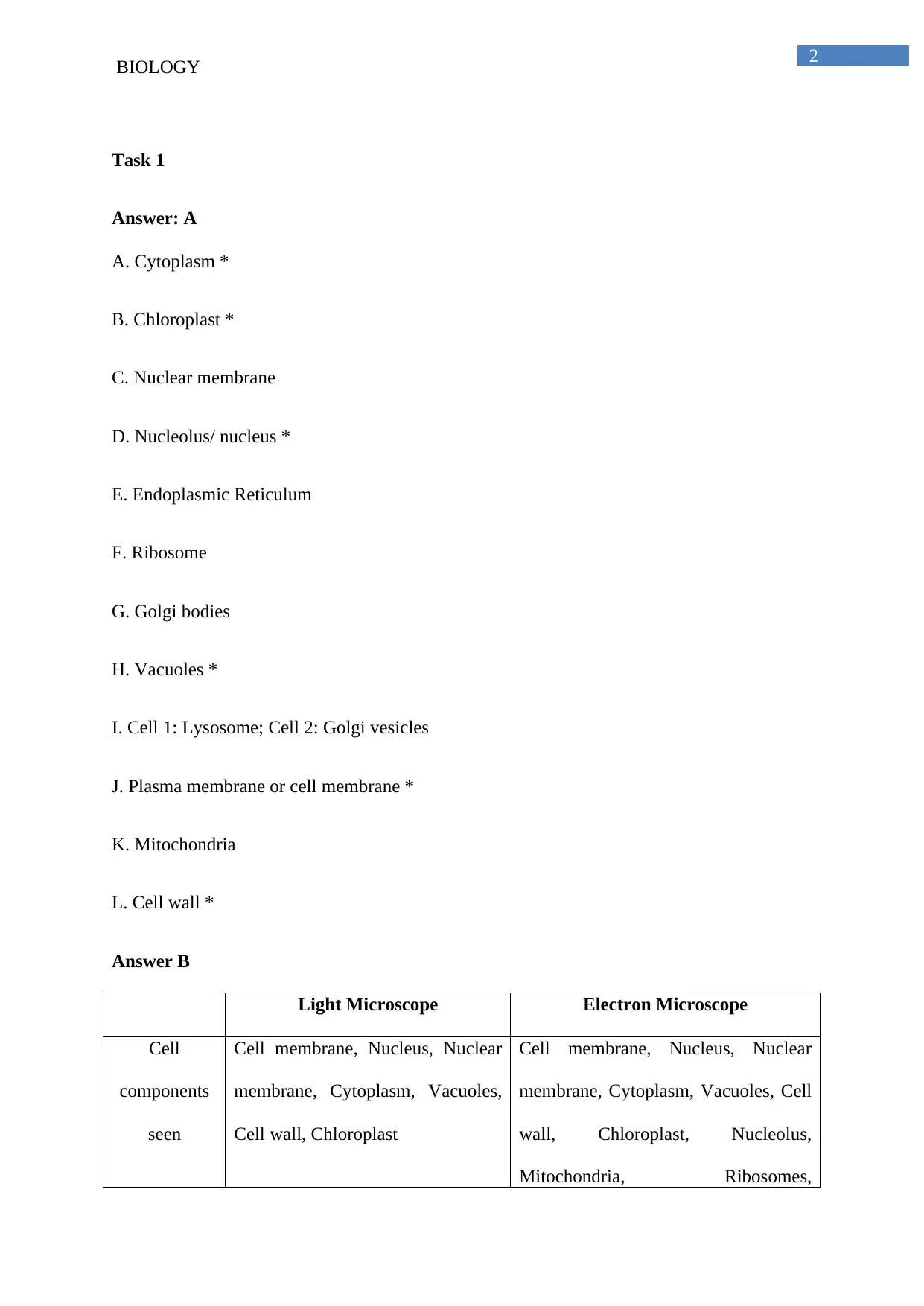
2
BIOLOGY
Task 1
Answer: A
A. Cytoplasm *
B. Chloroplast *
C. Nuclear membrane
D. Nucleolus/ nucleus *
E. Endoplasmic Reticulum
F. Ribosome
G. Golgi bodies
H. Vacuoles *
I. Cell 1: Lysosome; Cell 2: Golgi vesicles
J. Plasma membrane or cell membrane *
K. Mitochondria
L. Cell wall *
Answer B
Light Microscope Electron Microscope
Cell
components
seen
Cell membrane, Nucleus, Nuclear
membrane, Cytoplasm, Vacuoles,
Cell wall, Chloroplast
Cell membrane, Nucleus, Nuclear
membrane, Cytoplasm, Vacuoles, Cell
wall, Chloroplast, Nucleolus,
Mitochondria, Ribosomes,
BIOLOGY
Task 1
Answer: A
A. Cytoplasm *
B. Chloroplast *
C. Nuclear membrane
D. Nucleolus/ nucleus *
E. Endoplasmic Reticulum
F. Ribosome
G. Golgi bodies
H. Vacuoles *
I. Cell 1: Lysosome; Cell 2: Golgi vesicles
J. Plasma membrane or cell membrane *
K. Mitochondria
L. Cell wall *
Answer B
Light Microscope Electron Microscope
Cell
components
seen
Cell membrane, Nucleus, Nuclear
membrane, Cytoplasm, Vacuoles,
Cell wall, Chloroplast
Cell membrane, Nucleus, Nuclear
membrane, Cytoplasm, Vacuoles, Cell
wall, Chloroplast, Nucleolus,
Mitochondria, Ribosomes,
⊘ This is a preview!⊘
Do you want full access?
Subscribe today to unlock all pages.

Trusted by 1+ million students worldwide
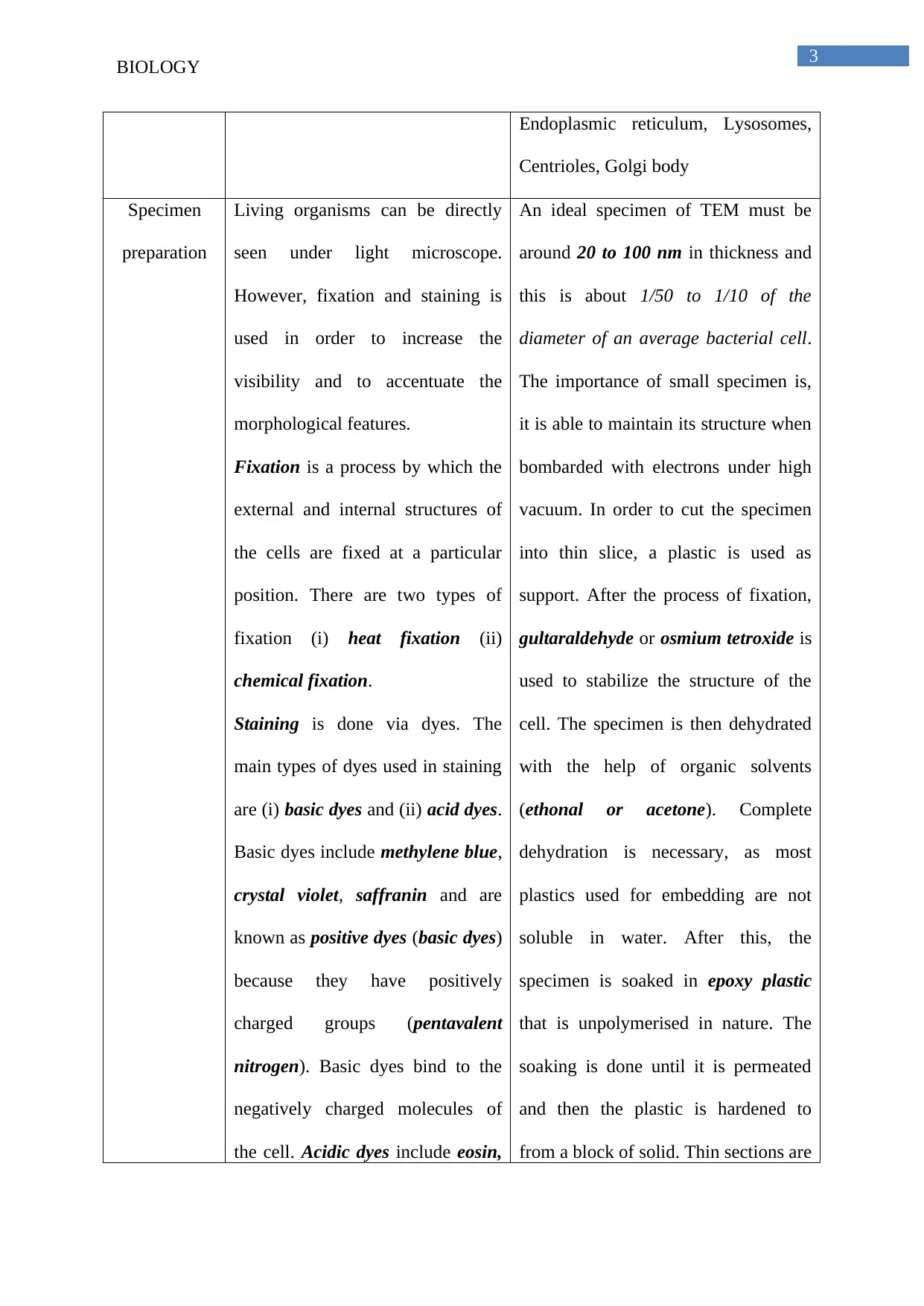
3
BIOLOGY
Endoplasmic reticulum, Lysosomes,
Centrioles, Golgi body
Specimen
preparation
Living organisms can be directly
seen under light microscope.
However, fixation and staining is
used in order to increase the
visibility and to accentuate the
morphological features.
Fixation is a process by which the
external and internal structures of
the cells are fixed at a particular
position. There are two types of
fixation (i) heat fixation (ii)
chemical fixation.
Staining is done via dyes. The
main types of dyes used in staining
are (i) basic dyes and (ii) acid dyes.
Basic dyes include methylene blue,
crystal violet, saffranin and are
known as positive dyes (basic dyes)
because they have positively
charged groups (pentavalent
nitrogen). Basic dyes bind to the
negatively charged molecules of
the cell. Acidic dyes include eosin,
An ideal specimen of TEM must be
around 20 to 100 nm in thickness and
this is about 1/50 to 1/10 of the
diameter of an average bacterial cell.
The importance of small specimen is,
it is able to maintain its structure when
bombarded with electrons under high
vacuum. In order to cut the specimen
into thin slice, a plastic is used as
support. After the process of fixation,
gultaraldehyde or osmium tetroxide is
used to stabilize the structure of the
cell. The specimen is then dehydrated
with the help of organic solvents
(ethonal or acetone). Complete
dehydration is necessary, as most
plastics used for embedding are not
soluble in water. After this, the
specimen is soaked in epoxy plastic
that is unpolymerised in nature. The
soaking is done until it is permeated
and then the plastic is hardened to
from a block of solid. Thin sections are
BIOLOGY
Endoplasmic reticulum, Lysosomes,
Centrioles, Golgi body
Specimen
preparation
Living organisms can be directly
seen under light microscope.
However, fixation and staining is
used in order to increase the
visibility and to accentuate the
morphological features.
Fixation is a process by which the
external and internal structures of
the cells are fixed at a particular
position. There are two types of
fixation (i) heat fixation (ii)
chemical fixation.
Staining is done via dyes. The
main types of dyes used in staining
are (i) basic dyes and (ii) acid dyes.
Basic dyes include methylene blue,
crystal violet, saffranin and are
known as positive dyes (basic dyes)
because they have positively
charged groups (pentavalent
nitrogen). Basic dyes bind to the
negatively charged molecules of
the cell. Acidic dyes include eosin,
An ideal specimen of TEM must be
around 20 to 100 nm in thickness and
this is about 1/50 to 1/10 of the
diameter of an average bacterial cell.
The importance of small specimen is,
it is able to maintain its structure when
bombarded with electrons under high
vacuum. In order to cut the specimen
into thin slice, a plastic is used as
support. After the process of fixation,
gultaraldehyde or osmium tetroxide is
used to stabilize the structure of the
cell. The specimen is then dehydrated
with the help of organic solvents
(ethonal or acetone). Complete
dehydration is necessary, as most
plastics used for embedding are not
soluble in water. After this, the
specimen is soaked in epoxy plastic
that is unpolymerised in nature. The
soaking is done until it is permeated
and then the plastic is hardened to
from a block of solid. Thin sections are
Paraphrase This Document
Need a fresh take? Get an instant paraphrase of this document with our AI Paraphraser
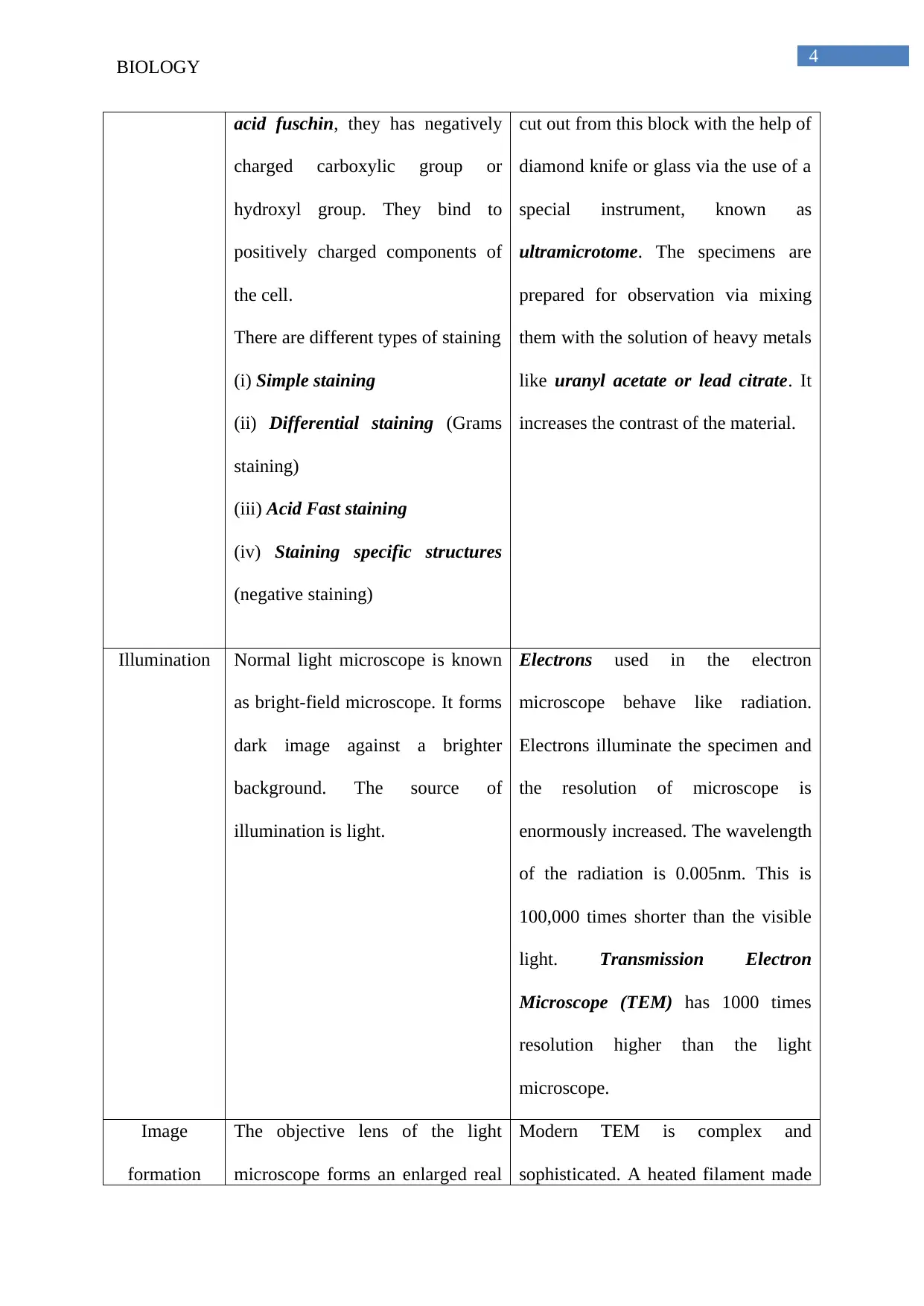
4
BIOLOGY
acid fuschin, they has negatively
charged carboxylic group or
hydroxyl group. They bind to
positively charged components of
the cell.
There are different types of staining
(i) Simple staining
(ii) Differential staining (Grams
staining)
(iii) Acid Fast staining
(iv) Staining specific structures
(negative staining)
cut out from this block with the help of
diamond knife or glass via the use of a
special instrument, known as
ultramicrotome. The specimens are
prepared for observation via mixing
them with the solution of heavy metals
like uranyl acetate or lead citrate. It
increases the contrast of the material.
Illumination Normal light microscope is known
as bright-field microscope. It forms
dark image against a brighter
background. The source of
illumination is light.
Electrons used in the electron
microscope behave like radiation.
Electrons illuminate the specimen and
the resolution of microscope is
enormously increased. The wavelength
of the radiation is 0.005nm. This is
100,000 times shorter than the visible
light. Transmission Electron
Microscope (TEM) has 1000 times
resolution higher than the light
microscope.
Image
formation
The objective lens of the light
microscope forms an enlarged real
Modern TEM is complex and
sophisticated. A heated filament made
BIOLOGY
acid fuschin, they has negatively
charged carboxylic group or
hydroxyl group. They bind to
positively charged components of
the cell.
There are different types of staining
(i) Simple staining
(ii) Differential staining (Grams
staining)
(iii) Acid Fast staining
(iv) Staining specific structures
(negative staining)
cut out from this block with the help of
diamond knife or glass via the use of a
special instrument, known as
ultramicrotome. The specimens are
prepared for observation via mixing
them with the solution of heavy metals
like uranyl acetate or lead citrate. It
increases the contrast of the material.
Illumination Normal light microscope is known
as bright-field microscope. It forms
dark image against a brighter
background. The source of
illumination is light.
Electrons used in the electron
microscope behave like radiation.
Electrons illuminate the specimen and
the resolution of microscope is
enormously increased. The wavelength
of the radiation is 0.005nm. This is
100,000 times shorter than the visible
light. Transmission Electron
Microscope (TEM) has 1000 times
resolution higher than the light
microscope.
Image
formation
The objective lens of the light
microscope forms an enlarged real
Modern TEM is complex and
sophisticated. A heated filament made

5
BIOLOGY
image within the microscope. The
eyepiece lens further magnifies the
primary image. When an observer
looks into a microscope, the
enlarged specimen image, known
as the virtual image appears to lie
beyond the stage. It generally lies
25 cm away.
of tungsten present inside the electron
gun generates a beam of electron that
is focused on the specimen via the
condenser. The electrons fail to pass
through a glass lens and hence a
doughnut-shaped electromagnets
known as magnetic lens are used to
focus the beam. The column
containing the pair of lenses and
specimen are placed under vacuum in
order to obtain a clear image. The
importance of creation of vacuum
space lies in the fact that, when
electrons collide with the air particles
they get deflected. The specimen
scatters the deflected electrons and the
refracted beam is then focused via
magnetic lenses to form a large visible
image of the specimen over projected
the fluorescent screen.
Magnificatio
n
The total magnification is
calculated via multiplying the
objective and the eyepiece
magnification.
The denser portion of the specimen
scatters more electrons and thus
appears darken in the image as fewer
electrons strike that area of the screen.
On contrary, electron transparent
BIOLOGY
image within the microscope. The
eyepiece lens further magnifies the
primary image. When an observer
looks into a microscope, the
enlarged specimen image, known
as the virtual image appears to lie
beyond the stage. It generally lies
25 cm away.
of tungsten present inside the electron
gun generates a beam of electron that
is focused on the specimen via the
condenser. The electrons fail to pass
through a glass lens and hence a
doughnut-shaped electromagnets
known as magnetic lens are used to
focus the beam. The column
containing the pair of lenses and
specimen are placed under vacuum in
order to obtain a clear image. The
importance of creation of vacuum
space lies in the fact that, when
electrons collide with the air particles
they get deflected. The specimen
scatters the deflected electrons and the
refracted beam is then focused via
magnetic lenses to form a large visible
image of the specimen over projected
the fluorescent screen.
Magnificatio
n
The total magnification is
calculated via multiplying the
objective and the eyepiece
magnification.
The denser portion of the specimen
scatters more electrons and thus
appears darken in the image as fewer
electrons strike that area of the screen.
On contrary, electron transparent
⊘ This is a preview!⊘
Do you want full access?
Subscribe today to unlock all pages.

Trusted by 1+ million students worldwide
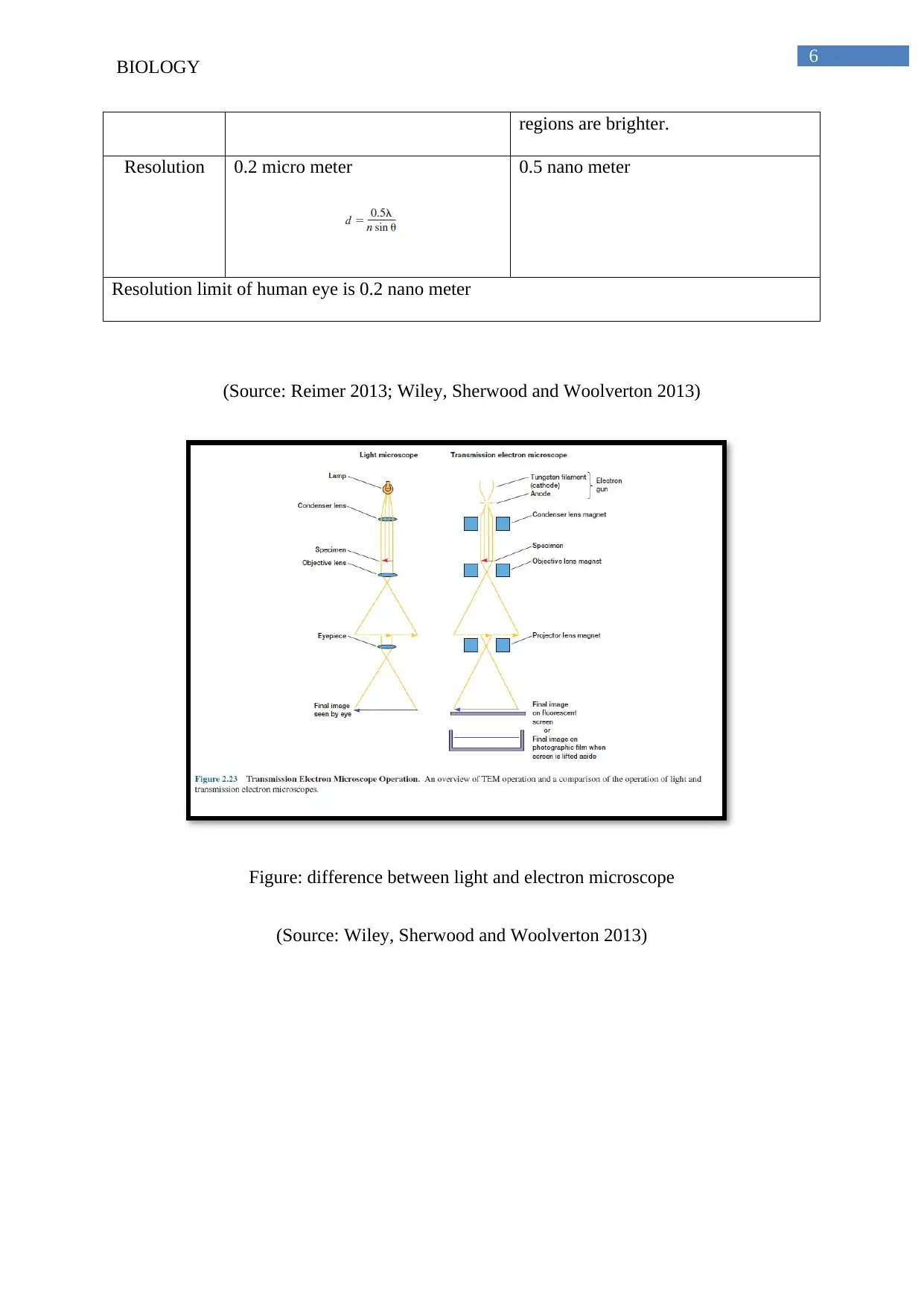
6
BIOLOGY
regions are brighter.
Resolution 0.2 micro meter 0.5 nano meter
Resolution limit of human eye is 0.2 nano meter
(Source: Reimer 2013; Wiley, Sherwood and Woolverton 2013)
Figure: difference between light and electron microscope
(Source: Wiley, Sherwood and Woolverton 2013)
BIOLOGY
regions are brighter.
Resolution 0.2 micro meter 0.5 nano meter
Resolution limit of human eye is 0.2 nano meter
(Source: Reimer 2013; Wiley, Sherwood and Woolverton 2013)
Figure: difference between light and electron microscope
(Source: Wiley, Sherwood and Woolverton 2013)
Paraphrase This Document
Need a fresh take? Get an instant paraphrase of this document with our AI Paraphraser
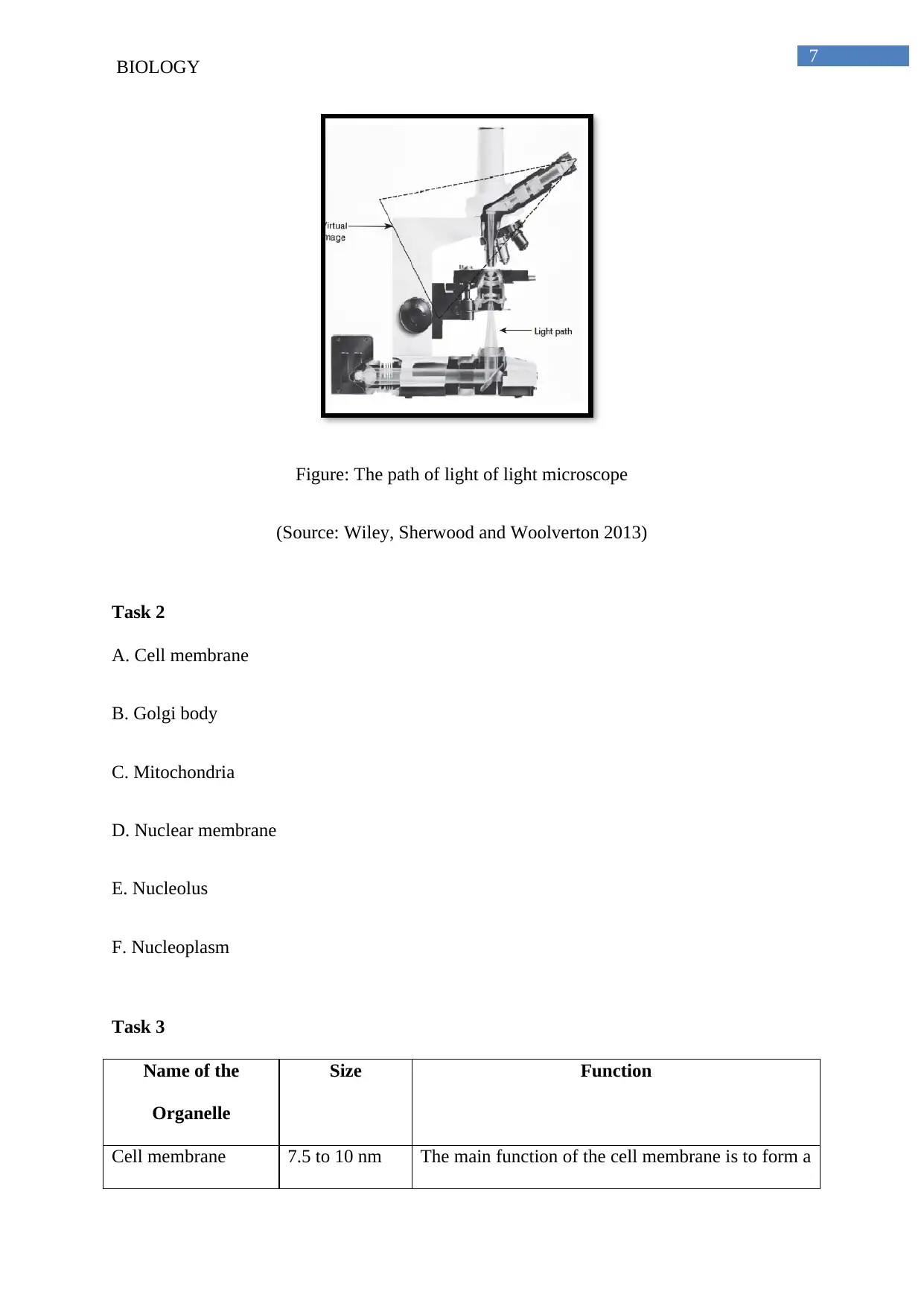
7
BIOLOGY
Figure: The path of light of light microscope
(Source: Wiley, Sherwood and Woolverton 2013)
Task 2
A. Cell membrane
B. Golgi body
C. Mitochondria
D. Nuclear membrane
E. Nucleolus
F. Nucleoplasm
Task 3
Name of the
Organelle
Size Function
Cell membrane 7.5 to 10 nm The main function of the cell membrane is to form a
BIOLOGY
Figure: The path of light of light microscope
(Source: Wiley, Sherwood and Woolverton 2013)
Task 2
A. Cell membrane
B. Golgi body
C. Mitochondria
D. Nuclear membrane
E. Nucleolus
F. Nucleoplasm
Task 3
Name of the
Organelle
Size Function
Cell membrane 7.5 to 10 nm The main function of the cell membrane is to form a
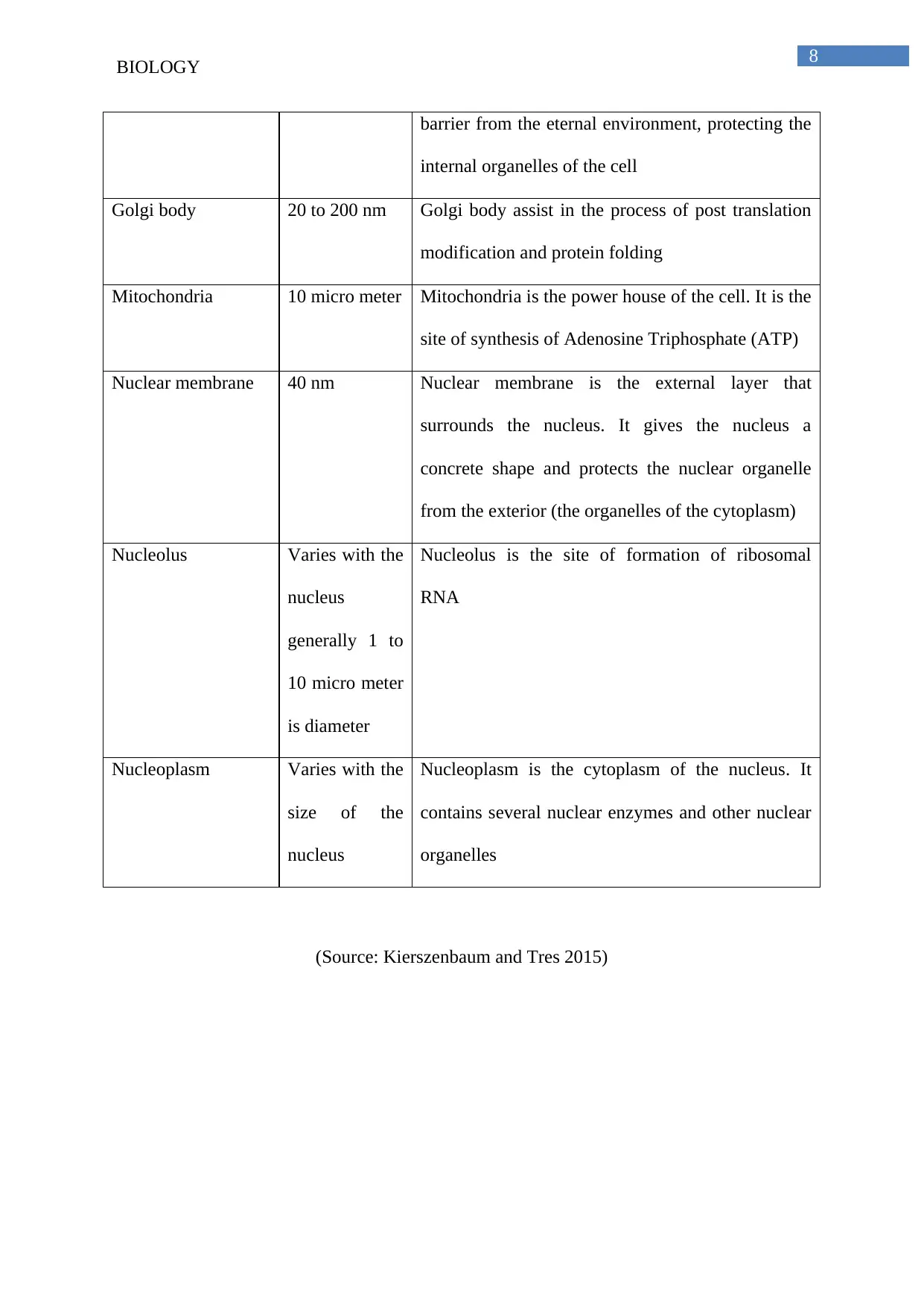
8
BIOLOGY
barrier from the eternal environment, protecting the
internal organelles of the cell
Golgi body 20 to 200 nm Golgi body assist in the process of post translation
modification and protein folding
Mitochondria 10 micro meter Mitochondria is the power house of the cell. It is the
site of synthesis of Adenosine Triphosphate (ATP)
Nuclear membrane 40 nm Nuclear membrane is the external layer that
surrounds the nucleus. It gives the nucleus a
concrete shape and protects the nuclear organelle
from the exterior (the organelles of the cytoplasm)
Nucleolus Varies with the
nucleus
generally 1 to
10 micro meter
is diameter
Nucleolus is the site of formation of ribosomal
RNA
Nucleoplasm Varies with the
size of the
nucleus
Nucleoplasm is the cytoplasm of the nucleus. It
contains several nuclear enzymes and other nuclear
organelles
(Source: Kierszenbaum and Tres 2015)
BIOLOGY
barrier from the eternal environment, protecting the
internal organelles of the cell
Golgi body 20 to 200 nm Golgi body assist in the process of post translation
modification and protein folding
Mitochondria 10 micro meter Mitochondria is the power house of the cell. It is the
site of synthesis of Adenosine Triphosphate (ATP)
Nuclear membrane 40 nm Nuclear membrane is the external layer that
surrounds the nucleus. It gives the nucleus a
concrete shape and protects the nuclear organelle
from the exterior (the organelles of the cytoplasm)
Nucleolus Varies with the
nucleus
generally 1 to
10 micro meter
is diameter
Nucleolus is the site of formation of ribosomal
RNA
Nucleoplasm Varies with the
size of the
nucleus
Nucleoplasm is the cytoplasm of the nucleus. It
contains several nuclear enzymes and other nuclear
organelles
(Source: Kierszenbaum and Tres 2015)
⊘ This is a preview!⊘
Do you want full access?
Subscribe today to unlock all pages.

Trusted by 1+ million students worldwide
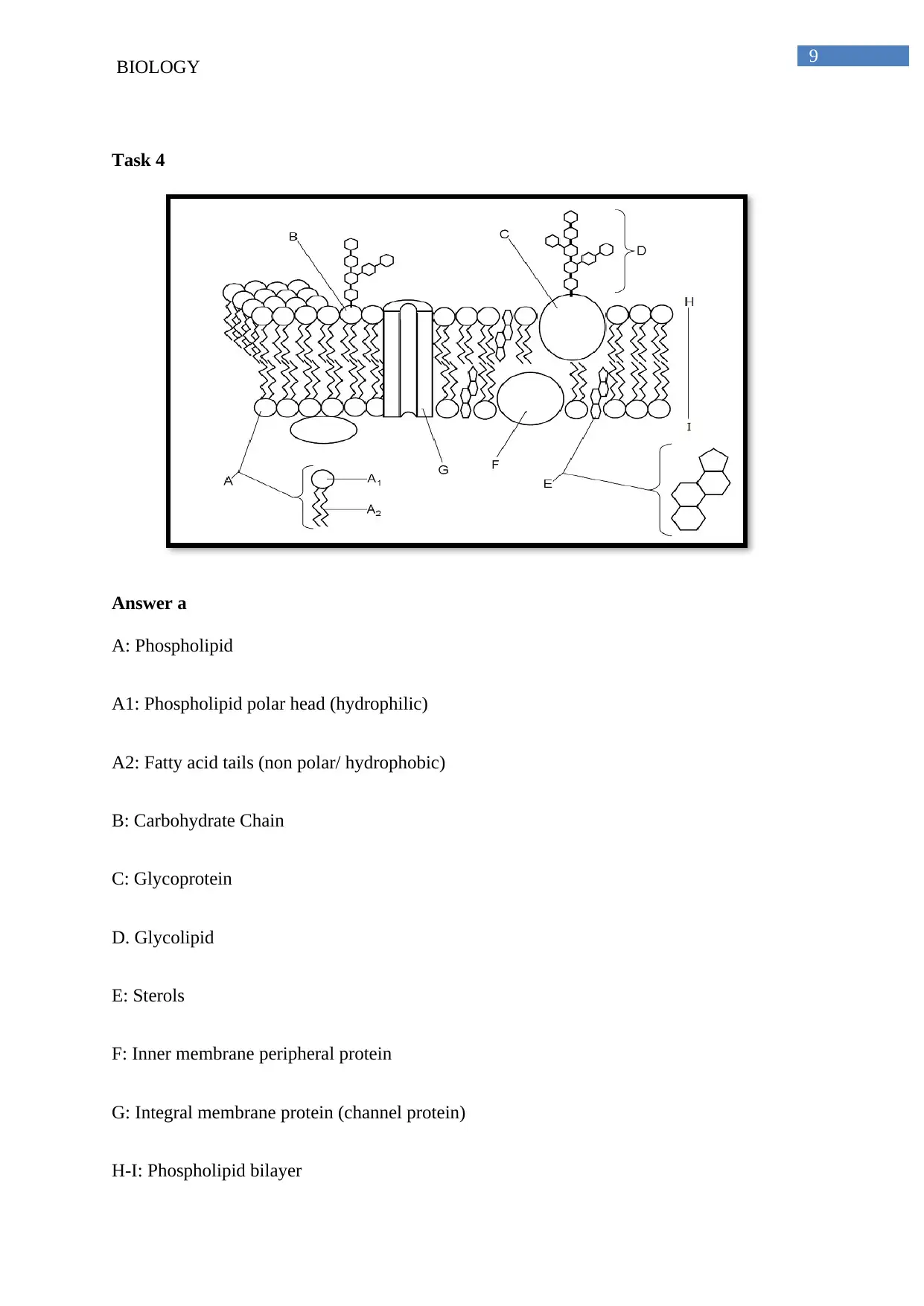
9
BIOLOGY
Task 4
Answer a
A: Phospholipid
A1: Phospholipid polar head (hydrophilic)
A2: Fatty acid tails (non polar/ hydrophobic)
B: Carbohydrate Chain
C: Glycoprotein
D. Glycolipid
E: Sterols
F: Inner membrane peripheral protein
G: Integral membrane protein (channel protein)
H-I: Phospholipid bilayer
BIOLOGY
Task 4
Answer a
A: Phospholipid
A1: Phospholipid polar head (hydrophilic)
A2: Fatty acid tails (non polar/ hydrophobic)
B: Carbohydrate Chain
C: Glycoprotein
D. Glycolipid
E: Sterols
F: Inner membrane peripheral protein
G: Integral membrane protein (channel protein)
H-I: Phospholipid bilayer
Paraphrase This Document
Need a fresh take? Get an instant paraphrase of this document with our AI Paraphraser

10
BIOLOGY
Answer b
The lipid component that anchors on the exoplasmic surface of the plasma membrane
is majorly Glycosylphosphatidylionositol (GPI). The phosphadityl inositol of this anchor
contains a fatty acyl chain that is extended up to the bilayer. The phosphoethanolamine in the
anchor links in to the protein (Opella 2013).
Answer c
The phospholipid bilayer is semi-permeable. This selective permeability of biological
membranes towards the small molecules allows cell to control and retain its internal
composition. The molecules that can pass freely through the phospholipid bilayer are small
uncharged molecules. O2 and CO2 are small non polar molecules and are soluble in the
phospholipid bilayer and thus can readily cross the cell member. H20, an example of small
uncharged polar molecules is capable of diffusing through the membrane. However, large
uncharged polar molecules like glucose cannot freely pass through the member and they need
support of carrier molecules along the expenditure of energy (Fragneto, Charitat and Daillant
2012).
BIOLOGY
Answer b
The lipid component that anchors on the exoplasmic surface of the plasma membrane
is majorly Glycosylphosphatidylionositol (GPI). The phosphadityl inositol of this anchor
contains a fatty acyl chain that is extended up to the bilayer. The phosphoethanolamine in the
anchor links in to the protein (Opella 2013).
Answer c
The phospholipid bilayer is semi-permeable. This selective permeability of biological
membranes towards the small molecules allows cell to control and retain its internal
composition. The molecules that can pass freely through the phospholipid bilayer are small
uncharged molecules. O2 and CO2 are small non polar molecules and are soluble in the
phospholipid bilayer and thus can readily cross the cell member. H20, an example of small
uncharged polar molecules is capable of diffusing through the membrane. However, large
uncharged polar molecules like glucose cannot freely pass through the member and they need
support of carrier molecules along the expenditure of energy (Fragneto, Charitat and Daillant
2012).

11
BIOLOGY
Figure: Selective Permeability of Phospholipid bilayer
(Source: Fragneto, Charitat and Daillant 2012).
Answer e
1) Glucose is transported via uniporter. GLUT1, is glucose uniporter. It is found in the
plasma membrane of the erythrocytes. Via uniporter, the transportation takes place down the
concentration gradient, without the expenditure of energy (Deng et al. 2014).
Figure: Transport of glucose via uniporter
(Source: Deng et al. 2014)
2) Water falls under the category of the small-uncharged polar molecules and is
readily diffusible across the phospholipid bilayer (Stein 2012).
3) Alcohol like ethanol also falls under the category of small-uncharged polar
molecules like that of water and is readily diffusible across the phospholipid bilayer (Stein
2012).
4) The size of the bacteria are many times larger than that of the viruses and thus they
are too large to enter inside the cell via receptor mediated endocytosis. Bacteria in the
majority of the cases enter the host cells via the process of phagocytosis. Phagocytosis of
bacteria is a normal function of macrophages. Macrophages patrol the infected tissues of the
BIOLOGY
Figure: Selective Permeability of Phospholipid bilayer
(Source: Fragneto, Charitat and Daillant 2012).
Answer e
1) Glucose is transported via uniporter. GLUT1, is glucose uniporter. It is found in the
plasma membrane of the erythrocytes. Via uniporter, the transportation takes place down the
concentration gradient, without the expenditure of energy (Deng et al. 2014).
Figure: Transport of glucose via uniporter
(Source: Deng et al. 2014)
2) Water falls under the category of the small-uncharged polar molecules and is
readily diffusible across the phospholipid bilayer (Stein 2012).
3) Alcohol like ethanol also falls under the category of small-uncharged polar
molecules like that of water and is readily diffusible across the phospholipid bilayer (Stein
2012).
4) The size of the bacteria are many times larger than that of the viruses and thus they
are too large to enter inside the cell via receptor mediated endocytosis. Bacteria in the
majority of the cases enter the host cells via the process of phagocytosis. Phagocytosis of
bacteria is a normal function of macrophages. Macrophages patrol the infected tissues of the
⊘ This is a preview!⊘
Do you want full access?
Subscribe today to unlock all pages.

Trusted by 1+ million students worldwide
1 out of 18
Related Documents
Your All-in-One AI-Powered Toolkit for Academic Success.
+13062052269
info@desklib.com
Available 24*7 on WhatsApp / Email
![[object Object]](/_next/static/media/star-bottom.7253800d.svg)
Unlock your academic potential
Copyright © 2020–2025 A2Z Services. All Rights Reserved. Developed and managed by ZUCOL.





